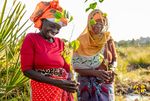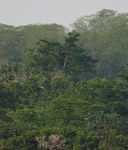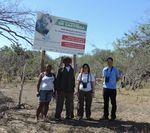Forest Update - Trillion Trees
←
→
Page content transcription
If your browser does not render page correctly, please read the page content below
www.trilliontrees.org
Forest Update 1
In recognition of this year’s launch Restoring the lungs of the city
of the UN Decade on Ecosystem in Tanzania
WWF Tanzania, the Tanzania Forest Service and local com-
Restoration, we’re celebrating some
munities are leading efforts to restore coastal forests near
of our amazing restoration projects. Dar es Salaam.
Pugu, Kazimzumbwi, and Vikindu Forests are the lungs of the city,
Despite the challenges that 2020 and are vestiges of some of the oldest forests in the world. These
forests are critical to the health of the city and the livelihoods of
presented, our partners continued
local communities. Protecting and restoring these remnants of a
the hard work to deliver the right once vast forest is crucial. Alongside efforts to protect this vital
landscape, tree planting events are organised with local schools
trees in the right places. Although the
and community groups to restore important tree species in the
stories in this newsletter highlight the degraded areas of the reserves. In 2020, WWF started Foresters
for the Future, which aims to plant 100 hectares – about 150,000
inspirational restoration work of the
trees – by training a cadre of young people who will plant trees
partners, in many landscapes there are in their communities and become advocates for the mainte-
nance of forests and wildlife in Tanzania.
also additional projects underway to
Of course, restoration and planting efforts were impacted by
protect standing forests.
Covid-19 over the last year, but the team is enthusiastic to get
back to work and to have planted 40,000 new seedlings by the
summer.
Watch the video
“The world is only beginning to realise that youth is a
powerful voice for the natural world. In Tanzania we
are yet to fully tap into this potential. Foresters for
the Future will unleash incredible positive change for
forests, wildlife, climate change action and connect
young people (and ultimately all of Tanzania) to nature.
Honestly, it’s the way to go!”.
Amani Ngusaru, Country Director, WWF Tanzania
© WWF Tanzania
Trillion Trees Forest Update March 2021 1Nature’s nurseries on Mount Kenya
In 2020 despite the Covid crisis, Nature Kenya
(a BirdLife Partner) successfully continued working with
three Community Forest Associations (CFAs) to deliver
the Mt. Kenya restoration initiative.
Local communities took advantage of the good rains to
restore degraded areas, taking all appropriate precautions
with masks and social distancing. In March-May, Nature
Kenya was able to plant 14,000 indigenous tree seedlings
with the Irangi CFA, and another 30,000 seedlings in Oc-
tober-December with the Lower Imenti and Kabaru CFAs.
These efforts are enhancing natural regeneration through-
out the nearly 34,000 hectares of indigenous forest areas
the CFAs are responsible for. Before planting started in Oc-
tober, the Lower Imenti CFA was able to start eradicating
invasive Lantana camara, which prevents natural regrowth
of the forest. So far, there has been a remarkable 90% sur-
vival rate for the planted seedlings.
Top: Area within Nyungwe where ferns have been cleared.
Standing dead trees are signs of forest fires that occurred in 1997.
Restoring the forests of Mt Kenya not only benefits the Bottom: A mixture of seedlings showing re-growth. © WCS Rwanda.
wildlife, but also the people who live in and around them.
The CFAs manage the tree nurseries and sell seedlings for Protecting vital resources in Rwanda
planting in and outside of Mt Kenya’s forests. One member
The best solutions are often the simplest. This has certain-
of the Lower Imenti CFA has been able to pay school fees
ly been the case in Nyungwe Forest National Park in Rwan-
for his children and finish building a house with the pro-
da’s southwest, whose degraded forest pockets demanded
ceeds of seedling sales and the labour to plant them.
a solution that would restore them to a wildlife haven and
Species planted in 2020 included Juniperus procera, protect them as a vital resource for locals.
Olea africana, Podocarpus falcutus, Croton megalocarpus,
In the 1990s, swathes of the park were destroyed by fires set
Bredilla micrantha, and Markhamia lutea.
by poachers and wild honey collectors and fuelled by unusu-
ally dry weather conditions. Around 10% of the 100,000 hectare
forest was lost – an area roughly equivalent in size to Barbados.
Colonies of bracken ferns emerged in its place, which suffocat-
ed the native seeds buried in the soil and increased the forest’s
vulnerability to future fires.
For Trillion Trees partner the Wildlife Conservation Society
(WCS) – which has supported conservation efforts in south-
west Rwanda for 25 years – restoring Nyungwe’s degraded
forest presented a win-win. WCS has spent a decade testing
approaches, and for Nyungwe, it landed on fern removal as the
most cost-effective method to restore the forest in burnt areas
– a technique known as assisted natural regeneration.
Just prior to the beginning of the pandemic in 2020, fern remov-
al started. Over the course of the year, WCS and local commu-
nities removed ferns across 70 hectares – equivalent to more
than 1,100 tennis courts. In just a few months, they restored an
entire hillside, where the first green shoots of new forest life are
now visible. Work will now continue across the park to make
Top: Aerial view of the tree nurseries.
Bottom: Member of the one of the CFAs in the tree nursery © Nature Kenya way for naturally regenerated forest to flourish.
Trillion Trees Forest Update March 2021 2Restoring biodiversity
in Uganda
Mabira Forest Reserve is the largest re-
maining forest in central Uganda, and
is close to three towns including Kam-
pala city. The forest is of critical impor-
tance for biodiversity conservation,
while also being a classroom and lab-
oratory for many schools in the central
and eastern region.
The proximity to the urban centres has
made Mabira Forest one of the most
popular forests in Uganda. Years of de-
Difference in regenerating plants in the fenced and non-fenced areas of the property. © SAVE Brasil
forestation have left the forest surround-
ed by agricultural settlements, and over
Bringing back wildlife in Brazil
5000 hectares of the forest remain highly
The Caatinga is the largest dry forest that dedicating land for conservation degraded and in need of restoration.
region in South America, and one of is vital and can be done at a minimal Nature Uganda has been working with
the richest dry forests in the world, in cost. On this farm, SAVE Brasil is also surrounding communities through col-
terms of biodiversity. But like other using the same method to create a laborative forest management initiatives
forests in Brazil (including the Ama- 7-hectare exclusion zone that will con- to protect and restore some areas.
zon and Atlantic Forests), this unique nect two patches of degraded forest.
Work started in early 2020 and, despite
ecoregion is under threat and is in In the second quarter of 2021, there are
delays caused by Covid-19, 500 hectares
desperate need of protection and further plans for an additional two ex-
of degraded forest is naturally regen-
restoration. clusion zones for natural regeneration
erating with a high density of sprouting
as well as active restoration and agro-
A few years ago, SAVE Brasil (BirdLife’s seedlings – as many as 250,000 trees.
forestry in the Atlantic forest of North-
partner in Brazil) partnered with local Now that national lockdown is being
eastern Brazil, in the Serra do Urubu –
farmers and created a conservation eased, Nature Uganda has already start-
Murici corridor.
zone to pilot-test a method to regen- ed community mobilisation to continue
erate native forest species which had While this project has been a huge with this vital work to restore the 5,000
disappeared due to overgrazing. The success for the Caatinga region, natu- hectare site through a combination of
owner of the farm was motivated to ral regeneration isn’t enough. In many assisted natural regeneration and plant-
restore the area to encourage native areas, degradation is too severe and ing of the appropriate native species in
wildlife species, such as the Spix’s ma- active restoration and conservation collaboration with the local community.
caw (classified as extinct in the wild) (including tree planting, agroforestry,
to return. It is his dream that one day and sustainable ranching) is underway
the birds will return through successful to save this unique landscape.
reintroduction programmes – and his
land will be ready for them.
Grazing goats were kept out by fenc-
ing off the conservation zone – a sim-
ple yet effective solution. As a result,
the young plant shoots have thrived.
Following this successful case, SAVE
Brasil is now doing something similar
in the Atlantic Forest – this time with-
in the property of a senator. This will Property owners and project field team below the
sign designating the property as a conservation area.
help set the precedent in the region © SAVE Brasil © Nature Uganda
Trillion Trees Forest Update March 2021 3You can also read


























































